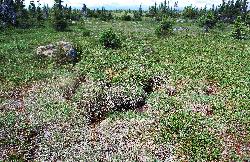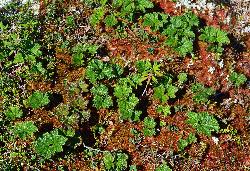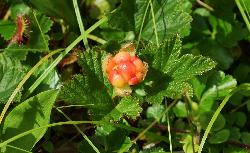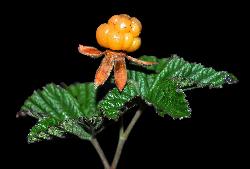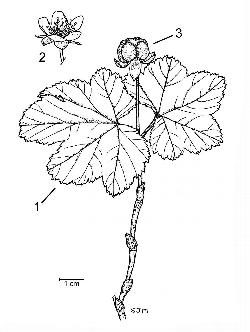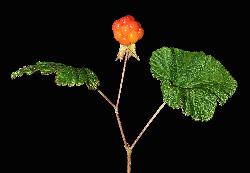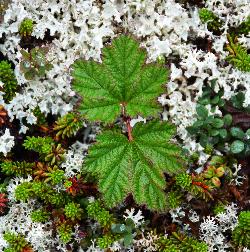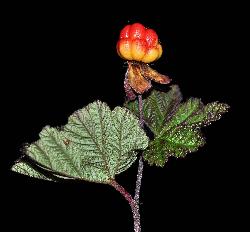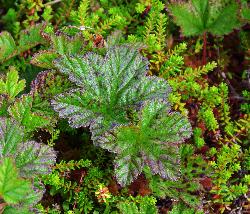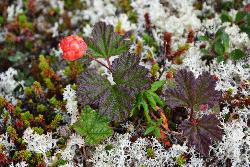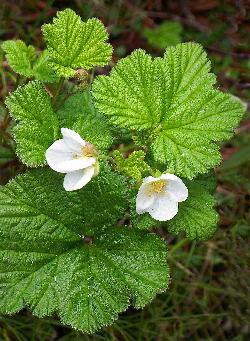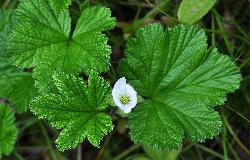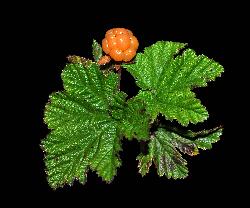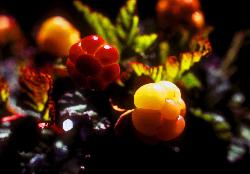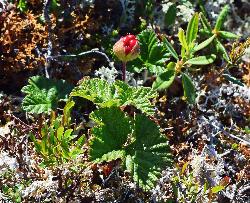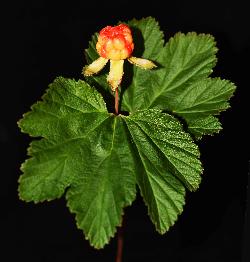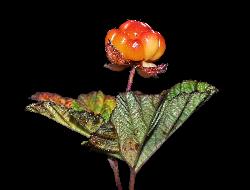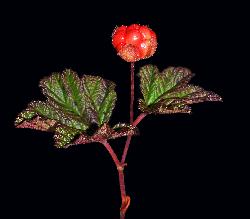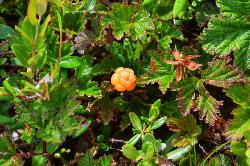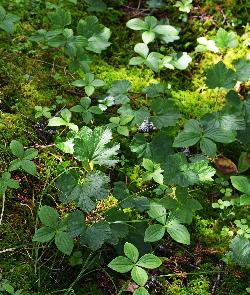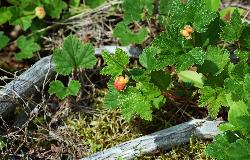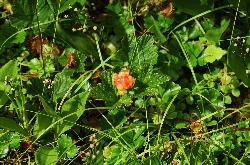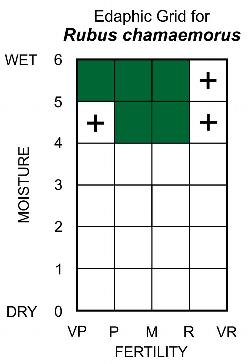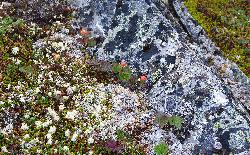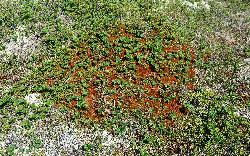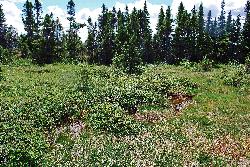Fr: chicouté, plaquebière, mûrier nain, plate-bière (SPM), ronce petit-mûrier
IA: shikuteuminanakashi, shikuteu
IU: appiKutik, appinnaKutik, appitsak (plants), appik (berry), aunik (yellow berry)
Rosaceae - Rose Family
Note: Numbers provided in square brackets in the text refer to the image presented above; image numbers are displayed to the lower left of each image.
General: A low perennial deciduous herb, with erect shoots, 1–2.5 dm tall, arising from a slightly woody creeping rhizome. Rubus chamaemorus is a shade-tolerant species. Although most commonly found in open raised bogs, it also occurs in peaty meadows or barrens, tundra, and wet forests with a Sphagnum moss understorey [1–4]. Bakeapples are a popular local fruit and an important economic food crop in northern Newfoundland and Labrador, providing fruit for jams, sauces, desserts, chocolates, and for making wines and liqueurs.
The preferred common name of Rubus chamaemorus in Newfoundland and Labrador is bakeapple, while other parts of Canada use the common name cloudberry. The origin of the common name bakeapple has long been reported in NL to be an anglicized version of the French phrase "baie qu'appelle?", which translates as "What is this berry called?" and reflects the rich historical influence of the French in Newfoundland. The common name 'baked-apple berry', reported in many online sources, is a misnomer, as the unique taste of bakeapple does not resemble in any manner the taste or texture of baked apples; therefore, use of the vernacular term 'baked-apple berry' is not recommended.
Key Features: (numbers 1–3 refer to the illustration [5])
- Leaves are simple, reniform to nearly orbicular, firm, and plicate, with crenate-serrate margins.
- Flowers are unisexual, with 1 white-petalled flower occurring on each stem.
- The fruit is an aggregate of few relatively large drupelets, initially red and opaque, but maturing to a rich translucent yellow-orange.
Stems/twigs: Young stems are unbranched, terete in cross-section, unarmed, and sparsely hairy, with straight and stipitate-glandular hairs on upper portions of the stem.
Leaves: Alternate, simple, petiolate, and stipulate, with 1–3 leaves per stem [6–7]. Petioles are 2–8 cm long, stipules are oblong to broadly ovate, 3–6 mm long, and present only on lower nodes. Leaf blades are reniform to orbicular, 2.5–6 cm long by 4–11 cm wide, somewhat coriaceous, plicate, and shallowly lobed, with 5–9 low rounded lobes [8]; bases are deeply cordate, apices are rounded, and margins are dentate to biserrate with blunt (obtuse) teeth. The upper surface is dark green and glabrous; the lower surface is paler and sparsely hairy with non-glandular and stipitate glandular hairs along the veins [9–10]. Leaves become mottled with purple, then turn dark purplish-green in autumn [11–12].
Flowers: Unisexual and dioecious, with a single male or female flower borne on separate flowering stems; flower stalks (pedicels) and calyx lobes are pubescent and bear few to many stipitate glandular hairs. Flowers are up to 2.5 cm across and have an open dish-shaped perianth. The calyx, most visible in fruiting plants, is pale yellowish, green, or red, with 5 deeply divided oblong to ovate lobes, pubescent on the outer surface, and with acute to blunt (obtuse), mucronate tips. The 4–5 petals are white, obovate, spreading, and 1–1.5 cm long. Male flowers have numerous stamens with slender filaments [13]. Female flowers have 10–20 pistils [14]; the ovaries are superior, and the slender styles persist in fruit. Small nectaries are located between the stamens and the inner edge of the hypanthium in male flowers, and between individual ovaries in female flowers (Brown and McNeil 2009).
Brown and McNeil (2009) reported that petals of male flowers are 2.3 mm longer on average than petals of female flowers, male flowers were also more numerous than female flowers, and when compared to female flowers, more male flowers have 5 petals than 4. Flowers bloom in mid-summer. As a dioecious plant, cross-pollination by insects (entomophily) is necessary for fruit and seed set in bakeapple. A study from southeastern Québec (Brown and McNeil 2009) identified insects from over 40 families visiting Rubus chamaemorus flowers during the 2–3 week flowering periods of 1999 and 2000. The most frequent visitors were hoverflies (Syrphidae), Helina flies (Muscidae), halictid bees (Halictidae), and bumblebees (Apidae). However, hover flies and halictid bees were described as the most effective pollinators, based on subsequent fruit set of visited flowers. Generally, insects landing on the male flowers collected and ate pollen, and, in the process, were dusted with pollen on their lower surface; they would also probe for nectar at the base of the flowers. When visiting female flowers, pollen was transferred to the stigmas while the insects probed for nectar, but less time was spent at female flowers than male flowers due to the lesser rewards (lack of pollen). Helina flies and halictid bees preferred bakeapple flowers (about 95%) over other species, based on analysis of pollen counts on the insects; in comparison, about 65% of the pollen identified on bumblebees was from bakeapple flowers (Brown and McNeil 2009).
Fruit: A dome-shaped aggregate fruit, 1.2–1.5 cm across, composed of a cluster of 10–20 relatively large coherent drupes (an aggregate of drupelets) [15–16]. In the early stages of maturation, the calyx encloses the developing fruit [17], but in ripe fruit, the calyx lobes are reflexed, often revealing lighter portions on the fruit, which correspond with the former position of the calyx [18–19]. Drupelets are initially firm, red, and opaque [20], but become soft when mature, with a rich translucent golden or yellowish-orange colour [16, 21], and separate easily from the short conical receptacle (torus). The fruit are edible and juicy, but slightly tart, with relatively large pits, 4–5 mm long, each containing one seed. Fruits mature in late summer to fall and are dispersed primarily by mammals and birds (endozoochory).
Ecology and Habitat: Within the forest, bakeapple most frequently occurs in low abundance in the open black spruce bog habitat on wet acidic peat soils. It has a wide range in light tolerance occurring from closed forests to open peatlands and tundra (Coladonato 1993). It is used as an indicator species to differentiate the black spruce-Sphagnum forest bog association [22–24].
Edaphic Grid: See image [25]: the Edaphic Grid for Rubus chamaemorus.
Forest Types: Bakeapple occurs sporadically in the following forest types.
- Abietum sphagnetosum (Sphagnum-Balsam Fir Forest Subassociation)
- Kalmio-Piceetum sphagnetosum (Sphagnum-Kalmia-Black Spruce Forest Subassociation)
- Sphagno-Piceetum (Sphagnum-Black Spruce Bog Association)
In southeastern Labrador, Foster (1984) recorded bakeapple consistently in the Spruce-Pleurozium Forest community and the Black Spruce-Sphagnum fuscum Forest community, and sporadically in the Black-Spruce-Feathermoss Forest community.
Bakeapple is rarely encountered in barren vegetation except as scattered plants in wet or peaty depressions and coastal barrens [26], where there is frequent fog. In the peatlands, bakeapple is most frequent and abundant on the relatively drier Coastal Bogs (Vaccinio-cladonietum boryi) and the Raised Bog Hummocks (Kalmio-Sphagnetum fusci) [27] where its cover ranges from 10–20% (Wells 1996). Also, within these types, there appears to be a trend towards higher cover in northern Newfoundland and eastern Labrador where the range is usually in the 20–40% cover. North of Lake Melville, bogs with over 75% cover of bakeapple have been observed [28]. Bakeapple also occurs regularly on the Fen Hummocks (Calamagrostio-Sphagnetum fusci) and Ribbed Fen Hummocks (Chamaedaphno-Sphagnetum angustifolii) of Labrador. Throughout most of the wetter flats and hollows of peatlands, bakeapple occurs only sporadically with less than 5% cover.
Succession: Bakeapple most frequently occurs in habitats that rarely burn, due to their wet soils, and are thus rarely harvested because of the very slow and stunted tree growth. However, bakeapple can survive fires of low to medium intensity and spread through underground rhizomes (Coladonato 1993). Foster (1985), working in southeastern Labrador, showed that bakeapple decreased from 50% to 21% frequency following fire in the Spruce-Pleurozium Forest community.
Distribution: Bakeapple is a northern boreal to subarctic circumpolar species that occurs in all provinces of Canada and occurs throughout Newfoundland and Labrador. In the United States, bakeapple occurs throughout most of Alaska, but only in portions of Maine, northern New Hampshire, northeastern Minnesota (USDA, NRCS 2016), and a single disjunct location on Long Island, NY (Alice et al. 2014); bakeapple also occurs across northern Eurasia (Hultén 1968).
Similar Species: There are a few other low Rubus species in Newfoundland and Labrador, but none other than R. chamaemorus has simple leaves or yellow-orange fruits, making it very easy to identify. Species with 3 leaflets and herbaceous above-ground shoots include plumboy (Rubus arcticus L. subsp. acaulis (Michx.) Focke) and dewberry (Rubus pubescens Raf.), also known as dwarf raspberry. Plumboy grows to about the same height as bakeapple and often grows in the same habitat, but has 3 dark green, ovate to obovate, coriaceous leaflets, flowers with 5–8 reddish-purple petals, and a deep ruby-red raspberry type fruit. Dewberry, more frequent in forest habitats, has more membranaceous leaves with diamond-shaped (rhomboidal) terminal leaflets; its flowers have erect, white to pale pinkish petals and the fruit is a deep red to dark purplish raspberry.


